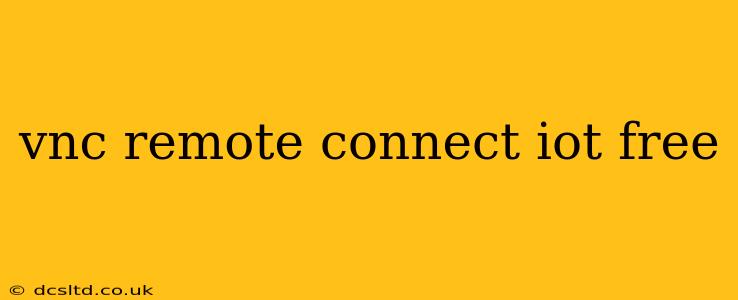The Internet of Things (IoT) is rapidly expanding, connecting more devices to the internet than ever before. Managing and monitoring these devices often requires remote access, and VNC (Virtual Network Computing) offers a powerful solution. But finding free and secure VNC options for IoT devices can be tricky. This article explores the possibilities, addressing common concerns and providing practical advice.
What is VNC and How Does it Work with IoT?
VNC is a graphical desktop-sharing system that lets you control a computer remotely. It works by transmitting the graphical user interface (GUI) of the remote computer to your local machine, allowing you to interact with it as if you were sitting in front of it. For IoT devices, VNC provides a way to access and manage their functionality from anywhere with an internet connection. This is particularly useful for devices embedded in difficult-to-reach locations or those needing constant monitoring.
Is there a free VNC client for IoT?
Several VNC clients offer free versions, but completely free and robust solutions for IoT specifically are less common. Many free options limit features or have restrictions on commercial use. The best choice depends on your specific needs and the operating system of your IoT device. Open-source options like TightVNC are often favored for flexibility and customizability. However, remember that free often means a trade-off in terms of support and advanced features.
How secure is VNC for IoT?
Security is paramount when remotely accessing devices, especially those on the internet. Standard VNC can be vulnerable to security risks if not properly configured. It’s crucial to use strong passwords, encrypt the connection (using protocols like TLS/SSL), and consider using a VPN for an added layer of security. Regularly updating your VNC server and client software is also essential to patch any known vulnerabilities. Choosing a VNC solution with built-in security features is vital for protecting your IoT devices.
What are the security risks of using VNC for IoT?
Unsecured VNC connections are easily susceptible to man-in-the-middle attacks, where a third party intercepts your connection, potentially stealing your credentials or modifying data. Unauthorized access can lead to data breaches, device compromise, and potential damage to your systems. Implementing robust security measures is non-negotiable.
How can I make my VNC connection more secure?
Prioritize using encrypted VNC connections (VNC over SSH is a good option). Use strong, unique passwords or consider two-factor authentication if available. Restrict access to your VNC server by only allowing connections from trusted IP addresses. Keep your VNC software updated with the latest security patches. Employ a firewall to limit network access to the VNC server.
What are the best free VNC alternatives for IoT?
While a completely free, feature-rich, and supremely secure solution might be elusive, some open-source alternatives provide a good starting point. RealVNC offers a free version, but their commercial version includes more robust security and support. Other open-source projects, frequently updated and maintained by the community, can offer viable options, though they might require more technical expertise to set up and maintain.
What are the limitations of free VNC for IoT?
Free VNC solutions often come with limitations such as restricted features, limited support, and potentially weaker security compared to paid alternatives. They may also lack advanced functionalities like performance optimization or detailed logging, crucial for managing IoT devices effectively. Scalability can also be a challenge with free versions as your IoT network expands.
Conclusion: Finding the Right Balance for Your IoT Needs
While completely free, enterprise-grade VNC solutions for IoT are rare, several options offer viable, secure connections with careful consideration of security best practices. Weighing the trade-offs between cost, features, security, and technical expertise is crucial when choosing a VNC solution for your specific IoT environment. Prioritizing security through encryption, strong passwords, and regular updates is non-negotiable for any VNC implementation in an IoT context.
